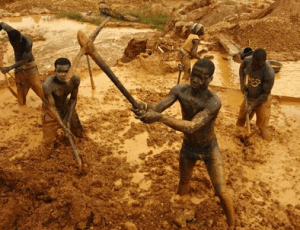Alluvial mining destroying River Pra
 Water is life as the popular saying goes because it’s an essential commodity for man’s survival since the resource constitutes 70 per cent of the human body and the earth.
Water is life as the popular saying goes because it’s an essential commodity for man’s survival since the resource constitutes 70 per cent of the human body and the earth.
Water also plays a major part in the productive life of Ghanaians for both domestic and industrial purposes.
In Ghana, there are 26 rivers including Ankobra, Tano, Bia and Densu that serve as source of drinking water, irrigation and other commercial purposes. Pra River is the largest of the three principal rivers that drain the area south of the Volta divide.
It originates from Kwahu Plateau, near Mpraeso in the Eastern Region and flows southward over 230 kilometres through rich cocoa and farming and forest areas in the Akan lowlands and enters the Gulf of Guinea in Shama.
The river has many cataracts, notably the Bosomasi Rapids at Anyinabrim and other tributaries like Ofin, Anum and Birim rivers.
River Pra is one of the major rivers in the Western Region that serves as a source of raw water for treatment by the Ghana Water Company Limited (GWCL) for distribution to more than one million residents in the Wassa East, Shama and Sekondi-Takoradi Metropolis.
However, since 2009, the river had suffered massive pollution as a result of illegal alluvial mining otherwise known as “galamsey”, which had turned the hitherto clean water into brownish colour.
The illegal miners placed “changfan” a type of mining machine introduced by the Chinese for alluvial mining, which dug the river bed in search of gold ore and in the process polluting it.
These miners who are armed with dangerous weapons have been waging war against security agencies who undertake swoops in their territories.
In 2013, the Western Regional Security Taskforce in a bid to clamp down on illegal mining undertook an unannounced operation against the galamseyers on the Pra River, but it ended up tragically with two naval ratings drowning in the river at Sekyere Wusuta in the Wassa East District.
The activities of the illegal miners have rendered the river unwholesome and threaten the very survival of the river and other surrounding water bodies.
The influx of the Chinese into the illegal gold business has worsened the situation as they hire the indigenes as labourers in their illegal activities and protect their investments with sophisticated weapons.
Sometimes, these Chinese open fires on Ghanaians who protest against the destructive effects of their activities on the environment. The river which previously boasts of many marine lives such as shrimps, periwinkles (Apofiee) and crabs are now extinct because of the pollutants in the river such as mercury and other dangerous chemicals used for processing the gold ore.
In spite of the Ministerial Taskforce which was established by the government in 2013 to combat the menace of illegal mining, the practice remains rife thus, destroying water bodies and polluting the environment.
The GWCL had constructed a water treatment plant at Bosomasi in the Wassa East District that pumps water from the Pra River for treatment and supplies about six million gallons of water per day to residents.
Water consumers from River Pra in recent times have been complaining that when they store treated water from the river, they observe dirt settling at the bottom of the storage facilities even though it has been treated by the water company.
Some consumers also experienced black particles in the water while others said the water flowing from their taps sometimes smells bad and brownish in colour.
Mr Mark Teiko Cudjoe, the Western Regional Manager of the GWCL, said the River Pra had deteriorated five times since 2010 to 2015 with the turbidity levels increasing from 199.66-908.18.
He said the Company in 2010 used 75.90 milligrams of Aluminum Sulphate (Alum) to treat a litre of raw water from the river, but as of 2015 it used 102.55 miligrams to treat the same quantity of water, and thus increased the cost of treatment.
“The extent of pollution of the Pra River is worrying and serious matter that needed collective efforts of all stakeholders to curb this menace,”, Mr Cudjoe pointed out.
The Regional Manager stated that small-scale mining should be done in places that would not have effects on water bodies because the mercury and other chemicals used in processing the ore could have devastating health implications on water consumers and the environment at large.
Meanwhile, the Regional Communication Officer of the GWCL, Mr Kwamena Acquah, noted that the activities of illegal miners in the river had choked its Daboase in-take point; therefore the company spent huge sums of money for desilting the silt from the point.
He said the company’s pumps found it extremely difficult to pump raw water from the river for treatment and the pumps often got damaged and warned that if the illegal mining continues, they may shut down the water plant at Bosomasi in the near future, saying the situation would cause severe water shortage in Sekondi-Takoradi and its surrounding communities.
The Communication Officer lamented that other stakeholders such as the Water Resources Commission, the Environmental Protection Agency and the Minerals Commission that supposed to safeguard the river and the environment are not doing enough to protect the river from pollution.
In this vein, it is important for the state institutions mandated to protect water bodies in the country to enforce section 81 and 99 of the new Minerals and Mining Act, 2006 (Act 703), in order to safeguard the health of the people.
By Godwill Arthur-Mensah
Source: GNA
